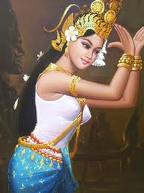The culture of Cambodia is strongly influenced by India, including the country’s language, religion, and other elements, like social structure. Today, it has strong links with the culture of Thailand, Laos and Myanmar,
with mutually intelligible languages, common food dishes, and shared customs.
 RELIGION
RELIGION
During the Khmer Rouge period in the 1970’s, virtually all religiousartefacts, temples, churches, and mosques were destroyed; they have subsequently been rebuilt. Almost 90% of Cambodians follow Therevada Buddhism, the Southern Path of the religion that originated from India. (The Northern Path is found in China, Korea and Japan) Therevada Buddhists believe that every male must spend some time of their life living in a temple, as a monk, with the ultimate goal of Nirvana, which releases human souls from desire, and suffering.
Plenty of Buddhist festivals are celebrated in Cambodia each year, and joining in the celebrations will be a rewarding experience for visitors, typically taking place in temples and pagodas. A small minority of Cambodians are Islamic, who can trace their roots back to the Cham culture in Central Vietnam. Christians are also a small minority, some of whom were converted during the times of the French.
 ETHNIC DIVERSITY
ETHNIC DIVERSITY
Nearly 97% of the country’s inhabitants are ethnic Khmers, with small minorities of Vietnamese, Chams, and ethnic Chinese, many of who live in Cambodia’s cities. Cambodia is home to several ethnic minorities, the largest of which is known as the Khmer Leu, who live in the country’s wild northeast. Because these communities do not wear colourful costumes like their cousins in Northern Thailand and Vietnam, they are of less interest to foreign visitors; these communities have never mixed with the ethnic Khmers, and have continued to practice their slash and burn agriculture today as they have for centuries. Less than 100,000 people in Cambodia are considered to be Khmer Leu.
ART
Few countries on earth have suffered such a devastating blow to their nation’s historical record than the Cambodians: in the space of 3 years, virtually all of Cambodian writings, Buddhist texts, sculptures and art were systematically destroyed. Today, most have been revived, and restored, with Cambodians enjoying
a revival of their country’s unique past. For visitors with a keen interest in Cambodian arts and culture, a visit to the Royal University of Fine Arts in Phnom Penh is a must, where children are being taught the elegant Khmer dance that once graced the temples of Angkor Wat.
Bali and Lombok Tourism, Java Tourism, Papua Tourism, China tourism, Thailand Tourism, Australia Tourism, Singapore, Cambodia, Hongkong, south Korea, malaysia, Japan, Philippinese Tourism, Japan, Vietnam, India and Tibet, Destination and Trips.
Pages
Download
Copyright © 2011-2012 Asia Tour and Tourism | Trip Destination and Holiday | Powered by Asiawonder












http://asiainternational.blogspot.com
ReplyDeleteBlogwalking for u
thanks share article